
 |
The Spotlight is on Mailer's Permit Postmarks
by Ken Lawrence
Would you like to cancel the stamps on the letters you mail? Although many collectors aren't aware of it, mailers in the United States are allowed to obtain and use their own cancellation devices. In fact, mailer's postmarks have been authorized - and in some cases, required - since 1924.
For more than 70 years, mailer's postmarks have been associated with precanceled postage - first with precanceled adhesive stamps, later as a way to precancel stamped envelopes and postal cards. Even though most precancel collectors would not regard these postal markings as part of their specialty, the current regulation for use of mailer's permit postmarks is titled, "Precancellation by Mailer."
Precanceled Stamps on First-Class Mail
On August 7, 1924, Third Assistant Postmaster General W. Irving Glover ruled that precanceled postage stamps could be used on first-class mail. To qualify for this privilege, mailers first had to secure a permit. They were required to presort the mail by city and state, and to face all the pieces uniformly in the same orientation.In essence, these were the same requirements that had applied to users of precanceled stamps on mailings of advertising circulars and samples of merchandise since the 19th century, but extended to business letters, orders, invoices, and payments.
Glover's order concluded, "Postmasters will please bring this matter to the attention of all persons using uncanceled stamps in coils on first-class matter and advise them that for their future needs the department will, in cases where the quantity mailed is sufficient to make use of precanceled stamps advantageous, furnish 2-cent precanceled stamps in coils which they may use on their first-class matter after obtaining permission therefor in the manner above set forth, thus expediting the handling of their first-class matter."
However, unlike the use of precanceled postage on second-, third-, and fourth-class mail, users of precancels on first-class mail were required to add dated cancellations, so that the stamps could not be reused: "The date of mailing in connection with lines similar to those used in a cancellation postmark shall be placed by the mailer on each piece of first-class matter."
Many precancel collectors have cursed this requirement ever since. Most specialists prefer to collect precancels without added cancellations, but many precanceled 2-cent coil stamps were used almost exclusively on first-class mail, and therefore have added mailer's postmarks. But while precancel collectors shun them, postmark and cover collectors can discover some wonderful, nonstandard postal markings by browsing dealer stocks for examples of precanceled stamps on first-class mail.
Here are six examples, showing the variety available:
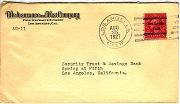 The Figure 1 cover bears a 2-cent carmine George Washington coil stamp, Scott 599, with a Los Angeles, Calif., precancel overprint applied by the Bureau of Engraving and Printing, canceled by the mailer on August 26, 1927. The cancellation consists of a double-ring datestamp adjacent to five horizontal killer bars. The cancel is sufficiently distinct that it can easily be identified as a mailer's postmark.
The Figure 1 cover bears a 2-cent carmine George Washington coil stamp, Scott 599, with a Los Angeles, Calif., precancel overprint applied by the Bureau of Engraving and Printing, canceled by the mailer on August 26, 1927. The cancellation consists of a double-ring datestamp adjacent to five horizontal killer bars. The cancel is sufficiently distinct that it can easily be identified as a mailer's postmark.
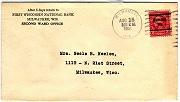 The stamp on the Figure 2 cover is a Milwaukee, Wis., Bureau precanceled 2-cent Washington sheet stamp, Scott 634. The handstamped cancellation has seven wavy lines in the killer, and the time of day is included inside the large August 15, 1931, circular datestamp.
The stamp on the Figure 2 cover is a Milwaukee, Wis., Bureau precanceled 2-cent Washington sheet stamp, Scott 634. The handstamped cancellation has seven wavy lines in the killer, and the time of day is included inside the large August 15, 1931, circular datestamp.
A year later, the cost of a first-class letter rose to three cents.
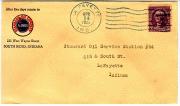 The Figure 3 cover shows a couple of other interesting aspects of these usages. The 3-cent deep violet George Washington sheet stamp, Scott 720, has a local precancel of Lafayette, Ind., in contrast to most others, which bear Bureau precancels. Even more interesting is the blue ink of the mailer's postmark, at a time when official postmarks were required to employ exclusively black ink for cancellations and magenta ink for registry and other special-purpose postmarks. Permit holders could use whatever colors of ink they wished.
The Figure 3 cover shows a couple of other interesting aspects of these usages. The 3-cent deep violet George Washington sheet stamp, Scott 720, has a local precancel of Lafayette, Ind., in contrast to most others, which bear Bureau precancels. Even more interesting is the blue ink of the mailer's postmark, at a time when official postmarks were required to employ exclusively black ink for cancellations and magenta ink for registry and other special-purpose postmarks. Permit holders could use whatever colors of ink they wished.
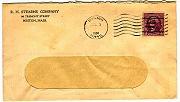 Figure 4 shows a Boston, Mass., Bureau precanceled 3-cent Washington coil stamp, Scott 721, with a July 3, 1934, machine cancellation. In this instance, the cancel was applied by the same Multipost equipment that affixed the stamp to the envelope.
Figure 4 shows a Boston, Mass., Bureau precanceled 3-cent Washington coil stamp, Scott 721, with a July 3, 1934, machine cancellation. In this instance, the cancel was applied by the same Multipost equipment that affixed the stamp to the envelope.
 On the Figure 5 cover, the 3-cent Washington Bureau precanceled Chicago, Ill., coil stamp has a double-ring datestamp with seven wavy killer lines, but also includes a boxed inscription that advertises the sender's business, a truly scarce cancellation style from what I've seen of mailer's postmark types.
On the Figure 5 cover, the 3-cent Washington Bureau precanceled Chicago, Ill., coil stamp has a double-ring datestamp with seven wavy killer lines, but also includes a boxed inscription that advertises the sender's business, a truly scarce cancellation style from what I've seen of mailer's postmark types.
 The Figure 6 window envelope lacks contents, but the 2-cent usage in 1937 suggests that it was a local letter to an address in Providence, R.I., where the cover was mailed. The handstamped mailer's postmark mimics a standard machine cancel.
The Figure 6 window envelope lacks contents, but the 2-cent usage in 1937 suggests that it was a local letter to an address in Providence, R.I., where the cover was mailed. The handstamped mailer's postmark mimics a standard machine cancel.
Adding Permit Numbers to Mailer's Postmarks
Privately applied markings that duplicated characteristics of official cancels posed a problem for the Post Office Department. Counterfeit dated cancels had the potential to undermine the integrity of court documents, patent applications, tax returns, and other first-class mail that depended on cancellation dates for verification.On October 1, 1938, Third Assistant Postmaster General Ramsey S. Black issued a revised order that required mailer's postmarks to be distinctive, so that they could not be mistaken for officially applied post office cancels.
"Referring to the provision under which precanceled stamps may be used in payment of postage on first-class matter, which contemplates that they shall be further defaced by the use of a postmark showing the date of mailing in a circle, together with lines similar to those used in a cancellation postmark, postmasters should inform permit holders using special devices for this purpose that in cases where the mailer's postmark includes only a single circle and is, therefore, like the official postmark, they should procure, as soon as possible, a new die which will either print a double circle or, if the single circle is preferred, the permit number of the mailer should be shown in the postmarking impression, either vertically between the circle and the wavy lines or immediately under the circle.
"In cases where a double circle is used, however, it will not be necessary to show the permit number.
"It is only with respect to the use of a single circle that the change is required in order to distinguish the mailer's postmark from the official postmark used in post offices, and to avoid any possible confusion which might result from the similarity of the postmark with a single circle, now being used by mailers of first-class matter bearing precanceled stamps, to the official postmark.
"Users of rubber handstamps for this purpose not meeting the foregoing requirements should procure new ones."
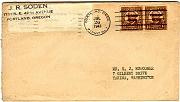 Figure 7 shows a pair of Bureau precanceled 1-1/2-cent brown Warren Harding coil stamps, Scott 686, used as first-class postage at Portland, Ore., on July 26, 1941, after this rule had gone into effect. The single-ring dial and five straight killer lines of the mailer's postmark simulate a post office machine cancel. At the bottom of the circular townmark is the "PERMIT No. 1" inscription. Although not really "under" the dial, the Portland postmaster evidently regarded it as complying with the regulation.
Figure 7 shows a pair of Bureau precanceled 1-1/2-cent brown Warren Harding coil stamps, Scott 686, used as first-class postage at Portland, Ore., on July 26, 1941, after this rule had gone into effect. The single-ring dial and five straight killer lines of the mailer's postmark simulate a post office machine cancel. At the bottom of the circular townmark is the "PERMIT No. 1" inscription. Although not really "under" the dial, the Portland postmaster evidently regarded it as complying with the regulation.
In 1941, mailers were authorized to use precanceled stamps on post cards as well as on first-class letters, but a February 19, 1943, ruling from the Third Assistant Postmaster General held that those stamps did not require mailer's postmarks. In effect, they were treated as second-, third-, and fourth-class mail for precancel purposes, but handled as first-class matter in the mailstream.
An interesting item to find would be a precanceled stamp on a post card mailed in 1941 or 1942, bearing a mailer's permit postmark. I haven't ever seen one.
Mailer's Postmarks on Stamped Envelopes
Shortly after the authorization to use precanceled stamps on first-class mail went into effect, a similar regulation was issued with respect to stamped envelopes. On March 3, 1925, Third Assistant PMG Glover ruled that mailers could use permit postmarks to precancel stamped envelopes for any class of mail matter.
 However, unlike the earlier authorization, this one required a specifically prescribed cancellation design, shown in Figure 8, that included the permit number prominently in the indicium, and did not resemble any official post office cancel style.
However, unlike the earlier authorization, this one required a specifically prescribed cancellation design, shown in Figure 8, that included the permit number prominently in the indicium, and did not resemble any official post office cancel style.
Not many commercial mailers took advantage of this opportunity, but some stamp collectors and dealers did. Gideon Ryder, treasurer of the Bureau Issues Association, explained the Figure 9 cover in the January 1943 Bureau Specialist.
 "Here in the Boston Postal District I know of only two permits for its use being issued; this one, No. 2, and No. 1 which was used several years ago by a stamp broker who mailed literature advertising a system for buying large quantities of commemorative stamps on credit as a long term investment...
"Here in the Boston Postal District I know of only two permits for its use being issued; this one, No. 2, and No. 1 which was used several years ago by a stamp broker who mailed literature advertising a system for buying large quantities of commemorative stamps on credit as a long term investment...
"In all my labors as Treasurer of several different philatelic societies, I have always tried to give the recipient of the bills for dues something in the form of 'peaches and cream' to sweeten up the due bill. This has taken the form of an odd envelope, or postmark, or stamp that would be of interest to them or to some friend who might be pursuing some side line of the hobby. So, in collusion with another B.I.A. member, who is always full of ideas, this cover was cooked up."
The red ink of the cancellation on the yellow envelope made an eye-catching combination, but by the time it was sent, the regulation for mailer's postmarks on postal stationery required blank ink.
Mailer's Postmarks on Postal Cards
On May 29, 1930 - five years after mailer's postmarks were authorized for use on stamped envelopes - the rule was extended to include government postal cards as well. At the same time, it became more restrictive. This was the date when permit holders were limited to the use of black ink on postal stationery cancellations.
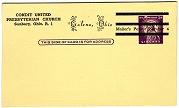 The prescribed format for the cancellation remained the same for stamped envelopes and postal cards. Nevertheless, just as some mailers ignored the ink color restriction, others took liberties with the design, evidently with their postmasters' approval. Figure 10 shows a Galena, Ohio, mailer's permit postmark used on a postal card in the 1950s.
The prescribed format for the cancellation remained the same for stamped envelopes and postal cards. Nevertheless, just as some mailers ignored the ink color restriction, others took liberties with the design, evidently with their postmasters' approval. Figure 10 shows a Galena, Ohio, mailer's permit postmark used on a postal card in the 1950s.
Mailer's Permit Postmarks Today
Postal regulations no longer separate mailer's postmarks into one category for stamps and another for postal stationery, nor are they limited to use on precanceled stamps. However, the prescribed style has changed again, requiring the use of wavy killer lines with the permit number included in the killer portion.
 The Figure 11 cover is a good example of the style authorized today, evidently printed onto the envelope by the same machine that affixed the non-denominated (10-cent) bulk rate Auto coil stamp, Scott 2905. The stamp itself is considered a precancel by the Postal Service, so the mailer's postmark is not necessary. However, some mailers believe that this addition causes it to appear less like other junk mail, therefore more likely to be opened and read by the recipient.
The Figure 11 cover is a good example of the style authorized today, evidently printed onto the envelope by the same machine that affixed the non-denominated (10-cent) bulk rate Auto coil stamp, Scott 2905. The stamp itself is considered a precancel by the Postal Service, so the mailer's postmark is not necessary. However, some mailers believe that this addition causes it to appear less like other junk mail, therefore more likely to be opened and read by the recipient.
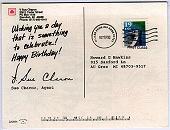 The Figure 12 postcard with a 19-cent Fishing Boat coil stamp, Scott 2529, also could have been mailed without the mailer's permit postmark, but in that case it would have needed a postal cancellation. By adding the mailer's postmark, the sender converted it to a precancel, which expedited its handling in the mailstream.
The Figure 12 postcard with a 19-cent Fishing Boat coil stamp, Scott 2529, also could have been mailed without the mailer's permit postmark, but in that case it would have needed a postal cancellation. By adding the mailer's postmark, the sender converted it to a precancel, which expedited its handling in the mailstream.
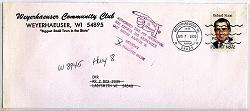 A mailer's postmark on the Figure 13 cover certainly added a dimension to its visual appeal, fortified further by the magenta pointing finger return marking.
A mailer's postmark on the Figure 13 cover certainly added a dimension to its visual appeal, fortified further by the magenta pointing finger return marking.
The Figure 14 cover is somewhat more complex. The 22-cent Pennsylvania commemorative, Scott 2337, had been issued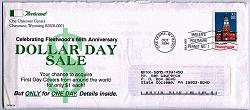 in 1987 as an ordinary letter rate stamp. But when it was used on a 1994 bulk rate mailing, the mailer's permit postmark was required, in order to convert the stamp into a precancel under postal regulations. The rules forbade the use of post office precancel devices on commemoratives, so the only way to achieve this usage was with a mailer's postmark.
in 1987 as an ordinary letter rate stamp. But when it was used on a 1994 bulk rate mailing, the mailer's permit postmark was required, in order to convert the stamp into a precancel under postal regulations. The rules forbade the use of post office precancel devices on commemoratives, so the only way to achieve this usage was with a mailer's postmark.
Foreign Mailer's Permit Postmarks
The United States is not the only country that issues permits to mailers for their own postmarks. The Figure 15 cover shows that the German rules are more liberal than our own, permitting the use of Mickey Mouse in a pictorial mailer's postmark design.Hermann E. Sieger, the world's largest stamp firm, uses a variety of topical subjects in its permit postmarks, which are eagerly sought by thematic collectors and exhibitors.
Your Own Mailer's Postmark
Section PO23.3.1 of the Domestic Mail Manual gives the rules for securing a mailer's postmark permit, which is free:
"A mailer must request authorization to preprint rate markings on precanceled stamps or to use a precancel postmark on adhesive stamps, postal cards, and stamped envelopes. The applicant must submit a specimen mailpiece showing the preprinting method or the proposed precancel postmark. If more than one format is used, a specimen showing each must be submitted. Form 3615 must be endorsed 'Preprinting of Rate Markings,' or "Mailer's Precancel Postmark,' or both, as appropriate."Because this is unfamiliar to many postal clerks and postmasters, you may have to refer them to the appropriate section of the DMM, cited here, to obtain the proper application form. However, one way to facilitate the process, and to find merchants who will manufacture postmark handstamps in the correct format, is to join the organization of collectors who specialize in this field.
The Mailer's Postmark Permit Club
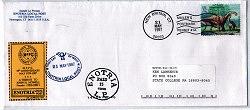 Figure 16 shows a recent cover canceled with the permit postmark of Joseph Lo Preiato, president of the Mailer's Postmark Permit Club. The club publishes a bimonthly bulletin, Permit Patter, each issue of which arrives in an envelope canceled with a mailer's postmark.
Figure 16 shows a recent cover canceled with the permit postmark of Joseph Lo Preiato, president of the Mailer's Postmark Permit Club. The club publishes a bimonthly bulletin, Permit Patter, each issue of which arrives in an envelope canceled with a mailer's postmark.Dues are $6 per year. For information, write to Florance M. Sugarberg, Treasurer, P.O. Box 5793, Akron, OH 44372-5793.
Details:
Figure 1. The mailer's postmark on this 1927 cover consists of a double-ring datestamp and five horizontal killer bars.Figure 2. This 1931 mailer's postmark, with seven wavy killer lines, includes the time of day inside the large circular datestamp.
Figure 3. This 1933 cover has two unusual aspects -- first class postage paid with a local precancel, and a mailer's postmark in blue ink.
Figure 4. The 1934 mailer's postmark on this cover was applied by the same Multipost machine that affixed the stamp to the envelope.
Figure 5. Besides the double-ring townmark and seven wavy killer lines, this 1935 mailer's postmark includes a boxed slogan that advertised the sender's business.
Figure 6. This 1937 mailer's postmark is a handstamp, but it resembles a standard post office machine cancel.
Figure 7. A rule change in 1938 required single-circle mailer's postmarks to include their permit numbers in the postmark imprint. This 1941 cover has a "PERMIT No. 1" mailer's postmark of Portland, Ore.
Figure 8. The officially authorized design for mailer's permit postmarks that could be used on stamped envelopes.
Figure 9. Almost all the users of mailer's permit postmarks on stamped envelopes were stamp collectors or stamp dealers. This example was mailed in 1942 or 1943.
Figure 10. Although this mailer's postmark failed to comply with the standard design rule, it was tolerated by the Galena, Ohio, post office in the 1950s.
Figure 11. A typical modern use of a mailer's permit postmark by a commercial mailer.
Figure 12. A mailer's permit postcard converted the ordinary 19-cent coil stamp into a precancel for mail handling purposes, expediting its travel to the addressee.
Figure 13. Here a mailer's permit postmark combines with a handsome magenta pointing finger auxiliary making to make a desirable collectible cover.
Figure 14. On this cover, the 22-cent commemorative has been converted into a bulk-rate precancel by the addition of a mailer's postmark.
Figure 15. The Mickey Mouse pictorial cancel on this German cover is a mailer's permit postmark used by Hermann E. Sieger, the world's largest stamp firm.
Figure 16. The Mailer's Postmark Permit Club is devoted exclusively to this type of collectible cover. This example displays the club president's postmark.
All scans by Sarah Collier